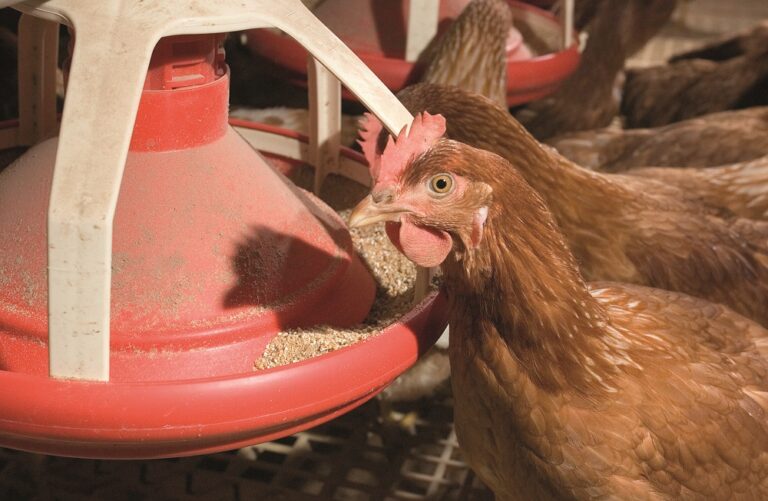If you need to adjust the average egg size that your flock is currently laying, then changing the birds’ diet will probably be the last thing you do.
The key influencers of egg size are a sequenced relationship of firstly the breed potential followed by the lighting programme, both during the rearing period and when coming into lay. It is only well into lay that the influence of feed can have impact.
The fine tuning of your flock’s diet may be all that is required to adjust the average egg size into the size category needed to improve your business’ viability.
A choice of feeds
If you need to increase your average egg size and your flock is already in lay, then you are left with the last tool in the box: nutrition. But you need to use a fine adjust screwdriver, not a hammer.
Many feed suppliers offer their egg producer customers a limited range of a few diets as the bird develops and progresses through its productive life. So why does a supplier like Humphrey Feeds & Pullets, with over 50 years of experience milling their own feeds offer around 300?
Sales director Martin Humphrey explains: “Over 300 diets sounds a lot! However, these do include different ranges, differentiated by GM and non-GM, natural vs nature, identical pigment as well as organic. Within each range of diets will be nearly 40 variations, based on a few key diets, each of which have slightly different nutritional objectives.
“Over the past 15 years, a laying bird’s performance has increased significantly. Modern hybrid birds are such finely tuned high performance athletes, so you have to be careful to avoid tripping them up by changing their diets too radically. Instead we give farmers the means to support their layers from our extensive range of diets which provide gradual and more frequent changes in the feed that they give to their birds.”
Individual flocks can have differing nutritional needs depending on their environment and circumstances. Humphrey Feeds & Pullets has a network of poultry experts who visit flocks on their farms and advise customers on the optimal feed type to utilise, as well as other aspects of bird management such as egg quality, flock health and longevity.
“Previously, customers often wanted to control and push down average egg weights,” says Humphrey, “so we offered a ‘Small Egg Size’ variations of the standard feeds. More recently, however, consumer demand has pushed for more large eggs so now we offer ‘Large Egg Size’ diets too.”
Welfare matters
“This is still relatively new territory,” says Humphrey. “We’re proceeding very cautiously to see how we can best encourage and support hens to produce larger eggs, whilst maintaining bird health and welfare.”
Producing too many eggs which are too large can cause stress, leading to feather loss and problems with thermo-regulation. When the outside temperature drops, the birds will eat more, compounding the problem of larger eggs.
Tradition versus a new approach
As the birds age egg production naturally dips whilst egg size increases. There are therefore advantages to altering feed to control egg size, whilst supporting bird welfare and shell quality.
Conventional thinking has been to step down the energy and nutrient content of diets after birds reach their optimum weight and production has started to decrease. However, over the last ten years the iso-kinetic range of diets has gained in popularity; the energy content is maintained, while most other nutrient levels are reduced.
Birds generally eat to their energy needs and a low energy diet encourages overfeeding. Whereas energy intake has little effect on egg size, decreasing the nutritional density of the diet can limit further increases in egg size.
Gently does it
Consumer demand for larger egg size has increased recently, but whichever way the average size needs to go, gradual change is best for production and for the birds’ health.
Egg producers should ensure that their feed supplier can deliver a finely tuned range of feeds in order to make slight but effective tweaks rather than radical leaps, which can shock the finely tuned athlete that is a modern hybrid laying bird.
Which ingredients impact egg size?
The bulk of feed consists of grain and proteins, along with oils and minerals to keep the bird healthy and nourished. Whilst the overall composition of the diet influences egg size, the nutrients which most affect it are:
Protein: comprised of amino acids of which methionine has the most significant effect on egg size and mass.
Oils: some oils are bound up within certain materials, and some oils are added on top. Oils have a range of complex fatty acid chains and selecting the right oil for the right fatty acid can influence egg size. A significant fatty acid is Linoleic acid.
Linoleic acid: The use of higher levels can have a positive effect on egg weight.
Calcium: whist it does not necessarily affect egg size it is important to support larger egg sizes with sufficient calcium in the feed.


